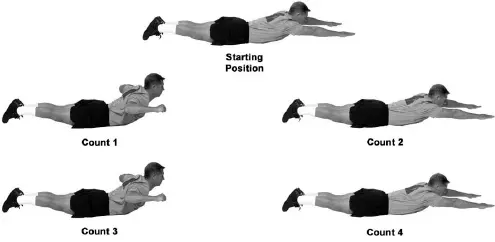The prone row is a simple but effective exercise for building a jacked upper back.
When you perform it with proper form, the prone row targets all the major muscle groups in your upper back; it strengthens your lats, mid-traps, rear delts, and rhomboids.
All you have to do is lie facedown on an exercise bench and lift weights by rowing them up the sides of your body. As the name implies, you do rows while lying prone.
Army PRT Prone Row Exercise
Purpose:
- This exercise develops strength in the back and shoulders.
Starting Position:
- Prone position with the arms overhead, palms down, fingers and thumbs extended and joined, 1 to 2 inches off the ground, and toes pointed to the rear.
Cadence:
- SLOW
Count:
- Raise the head and chest slightly while lifting the arms and pulling them rearward. Hands make fists as they move toward the shoulders.
- Return to the starting position.
- Repeat count 1.
- Return to the starting position.

Check Points:
- At the starting position, the abdominal muscles are tight, and the head is aligned with the spine.
- On counts 1 and 3, the forearms are parallel to the ground and slightly higher than the trunk.
- On counts 1 and 3, the head is raised to look forward but not skyward.
- Throughout the exercise, the legs and toes remain in contact with the ground.
Precautions:
- This exercise is always performed at a slow cadence. Prevent overarching of the back by maintaining contractions of the abdominal and buttock muscles throughout the exercise.
Prone Dumbbell Row
The Prone Dumbbell Row is a strength training exercise that targets your back, shoulders, and arms muscles.
- The prone position means you are face-down when performing this exercise.
How to Do Prone Dumbbell Row Correctly
One of the best things about the prone row is its ease. There is little technique required. Even as a novice, you can do this exercise correctly.
Here’s a step-by-step tutorial for doing the prone row:
- Lie face down on an exercise bench or the floor. Ensure your arms are extended below your shoulders, hands holding dumbbells or a bar. Keep your core engaged and back straight.
- Lift the weights upward by squeezing your shoulder blades together and retracting your shoulder blades. Focus on activating your mid and upper back muscles. Only lift the weights as comfortably as you can while maintaining the form.
- Slowly lower the weights back to the starting position in a controlled motion. Avoid just dropping the weights and focus on using your muscles to lower them.
- Repeat movements. You can start with a lighter weight and build up as you get comfortable with the movement.
It can be tough to do bench presses without proper weightlifting equipment. Even so, it’s essential to stabilize your body on the bench you’re using.
Having a stable surface is crucial for this exercise; otherwise, you risk injury.
Benefits of Prone Row Exercise
- The bench press primarily targets your chest, triceps, and shoulders. The prone row strengthens all those areas and even more muscle groups.
- In addition to working your larger back muscles, the prone row activates your mid and upper trapezius, rear deltoids, and various smaller stabilizer muscles.
- Like most weightlifting exercises, the prone row provides benefits beyond just building muscle. It can improve your fitness, health, mental focus, and discipline.
- As you progress through your sets, you’ll find yourself lifting for a bit longer each time and pushing through to the completion of the set instead of giving up halfway.
- The extra range of motion and concentration required to perform the prone row with proper form makes it a more total body exercise than flat bench presses.
- Your back will feel stronger and tighter, and your arms, shoulders, and core will reap the toning benefits.
- The prone row is an excellent accessory exercise to complement machines and free weight exercises targeting your upper back and posterior chain.
Conclusion
- The prone position may seem basic, but there are key details to master for safe and effective results.
- While the movement is straightforward, improper execution can strain your shoulders, wrists, and fingers.
- To minimize the risk of injury, we highly recommend having an experienced trainer observe your form during the initial stages.
- Empowering Transactions: Navigating Firearms Sales with Proper Documentation - April 8, 2024
- Army PRT – Preparation and Recovery 2024 - March 18, 2024
- Active and Reserve Components 2024 - March 6, 2024
